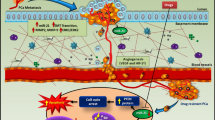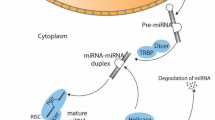Abstract
Prostate cancer is the leading cause of death among men worldwide. Deregulation of microRNAs has been reported in many cancers. Expression of microRNAs miR-20a-5p, miR-21-5p, miR-100-5p, miR-125a-5p and miR-146a-5p in tissue blocks of histologically confirmed prostate cancer patients compared with BPH patients, to identify potential microRNA biomarker for prostate cancer. MicroRNA was isolated and expression was quantified by qRT-PCR using Taqman Advanced microRNA assay kits. The interactions between the microRNA:target mRNA were predicted by using bioinformatics tools such as miRwalk and miRTargetlink. The experimentally validated targets were analysed using gprofiler to identify their molecular function, biological process and related pathways. The expression analysis revealed that miR-21 and miR-100 were significantly down-regulated whereas miR-125a was up-regulated in prostate cancer patients. Comparative analysis of the expression levels with tumor grading reveal that miR-100 was significantly down-regulated (p < 0.05) in high grade tumor, indicating that miR-100 associated with prostate cancer. ROC analysis revealed that combined analysis of down-regulated miRNAs (miR-21 and miR-100) shown AUC of 0.72 (95% CI 0.65–0.79). The combined analysis of all five miRNAs showed AUC of 0.87 (95% CI 0.81–0.92). The targets prediction analysis revealed several validated targets including BCL2, ROCK1, EGFR, PTEN, MTOR, NAIF1 and VEGFA. Our results provide evidence that combined analysis of all the five miRNAs as a panel can significantly improve the prediction level of the presence of prostate cancer and may be used as a potential diagnostic biomarker.





Similar content being viewed by others
References
Rawla P (2019) Epidemiology of prostate cancer. World journal of oncology 10(2):63. https://doi.org/10.14740/wjon1191
Jain S, Saxena S, Kumar A (2014) Epidemiology of prostate cancer in India. Meta Gene 2:596–605. https://doi.org/10.1016/j.mgene.2014.07.007
Cary KC, Cooperberg MR (2013) Biomarkers in prostate cancer surveillance and screening: past, present, and future. Ther Adv Urol 5(6):318–329. https://doi.org/10.1177/1756287213495915
Adhyam M, Gupta AK (2012) A review on the clinical utility of PSA in cancer prostate. Indian J Surg Oncol 3(2):120–129. https://doi.org/10.1007/s13193-012-0142-6
Ayub SG, Kaul D, Ayub T (2015) Microdissecting the role of microRNAs in the pathogenesis of prostate cancer. Cancer Genet 208(6):289–302. https://doi.org/10.1016/j.cancergen.2015.02.010
Ewquela-Kerscher A, Slack FJ (2006) Oncomirs-microRNAs with a role in cancer. Nat Rev Cancer 6(4):259–269. https://doi.org/10.1038/nrc1840
Kasinski AL, Slack FJ (2011) MicroRNAs en route to the clinic: progress in validating and targeting microRNAs for cancer therapy. Nat Rev Cancer 11(12):849–864. https://doi.org/10.1038/nrc3166
Stahlhut C, Slack FJ (2013) MicroRNAs and the cancer phenotype: profiling, signatures and clinical implications. Genome Med 5(12):111. https://doi.org/10.1186/gm516
Wach S, Nolte E, Szczyrba J et al (2012) MicroRNA profiles of prostate carcinoma detected by multiplatform microRNA screening. Int J Cancer 130(3):611–621. https://doi.org/10.1002/ijc.26064
Carlsson J, Davidsson S, Helenius G et al (2011) A miRNA expression signature that separates between normal and malignant prostate tissues. Cancer Cell Int 11(1):14. https://doi.org/10.1186/1475-2867-11-14
Zhong J, Huang R, Su Z et al (2017) Downregulation of miR-199a-5p promotes prostate adeno-carcinoma progression through loss of its inhibition of HIF-1α. Oncotarget 8(48):83523. https://doi.org/10.18632/oncotarget.18315
Jia HY, Wang YX, Yan WT et al (2012) MicroRNA-125b functions as a tumor suppressor in hepatocellular carcinoma cells. Int J Mol Sci. https://doi.org/10.3390/ijms13078762
Damodaran M, Paul SF, Venkatesan V (2020) Genetic polymorphisms in miR-146a, miR-196a2 and miR-125a genes and its association in prostate cancer. Pathol Oncol Res. https://doi.org/10.1007/s12253-018-0412-x
Epstein JI, Zelefsky MJ, Sjoberg DD et al (2016) A contemporary prostate cancer grading system: a validated alternative to the Gleason score. Eur Urol 69(3):428–435. https://doi.org/10.1016/j.eururo.2015.06.046
Kiener M, Chen L, Krebs M et al (2019) miR-221-5p regulates proliferation and migration in human prostate cancer cells and reduces tumor growth in vivo. BMC Cancer. https://doi.org/10.1186/s12885-019-5819-6
Dweep H, Gretz N (2015) miRWalk2. 0: a comprehensive atlas of microRNA-target interactions. Nature Methods 12(8):697. https://doi.org/10.1038/nmeth.3485
Hamberg M, Backes C, Fehlmann T et al (2016) MiRTargetLink—miRNAs, genes and interaction networks. Int J Mol Sci 4:564. https://doi.org/10.3390/ijms17040564
Jüri R, Meelis K, Hedi P et al (2007) g: Profiler-a web-based toolset for functional profiling of gene lists from large-scale expriments. Nuc Aci Res 35:w193-200. https://doi.org/10.1093/nar/gkm226
https://www.socscistatistics.com/tests/studentttest/default.aspxs
Ding HY, Qian WQ, Xu J (2016) MicroRNA-146b acts as a potential tumor suppressor in human prostate cancer. J Balk Union Oncol 21:434–443
Porkka KP, Pfeiffer MJ, Waltering KK et al (2007) MicroRNA expression profiling in prostate cancer. Can Res 67(13):6130–6135. https://doi.org/10.1158/0008-5472
Filella X, Foj L (2017) miRNAs as novel biomarkers in the management of prostate cancer. Clin Chem Lab Med 55(5):715–36. https://doi.org/10.1515/cclm-2015-1073
Zhang B, Pan X, Cobb GP, Anderson TA (2007) microRNAs as oncogenes and tumor suppressors. Dev Biol 302(1):1–12. https://doi.org/10.1016/j.ydbio.2006.08.028
Henson BJ, Bhattacharjee S, O’Dee DM et al (2009) Decreased expression of miR-125b and miR-100 in oral cancer cells contributes to malignancy. Genes Chromosom Cancer 48(7):569–582. https://doi.org/10.1002/gcc.20666
Volinia S, Calin GA, Liu CG, Ambs S et al (2006) A microRNA expression signature of human solid tumors defines cancer gene targets. Proc Natl Acad Sci USA 103(7):2257–2261
Li C, Gao Y, Zhang K et al (2015) Multiple roles of microRNA-100 in human cancer and its therapeutic potential. Cell Physiol Biochem 37(6):2143–2159. https://doi.org/10.1159/000438572
Leite KR, Morais DR, Reis ST, Viana N et al (2013) MicroRNA 100: a context dependent miRNA in prostate cancer. Clinics 68(6):797–802. https://doi.org/10.6061/clinics/2013(06)12
Fu Y, Cao F (2015) MicroRNA-125a-5p regulates cancer cell proliferation and migration through NAIF1 in prostate carcinoma. Onco Targets Ther 8:3827. https://doi.org/10.2147/OTT.S92314
Acknowledgements
This work was financially supported by Department of Biotechnology, Government of India 6242-P58/RGCB/PMD/DBT/VVSL/2015.
Funding
This work was financially supported by Department of Biotechnology, Government of India 6242-P58/RGCB/PMD/DBT/VVSL/2015.
Author information
Authors and Affiliations
Contributions
I would like to acknowledge all the authors who have contributed significantly to this paper; MD, has given the substantial contribution in data collection, analysis, interpretation of the data and drafting the manuscript. MCD, SDR and SS helped and contributed samples for the study, SVR and RI provided external supervision for the research activity. Revision and final approval of the version to be published and the primary responsibility for communication with the journal during manuscript submission was done by VV (Corresponding author).
Corresponding author
Ethics declarations
Conflict of interest
The authors did not have any conflict of interest.
Additional information
Publisher's Note
Springer Nature remains neutral with regard to jurisdictional claims in published maps and institutional affiliations.
Rights and permissions
About this article
Cite this article
Damodaran, M., Chinambedu Dandapani, M., SimonDuraiRaj et al. Differentially expressed miR-20, miR-21, miR-100, miR-125a and miR-146a as a potential biomarker for prostate cancer. Mol Biol Rep 48, 3349–3356 (2021). https://doi.org/10.1007/s11033-021-06384-z
Received:
Accepted:
Published:
Issue Date:
DOI: https://doi.org/10.1007/s11033-021-06384-z




